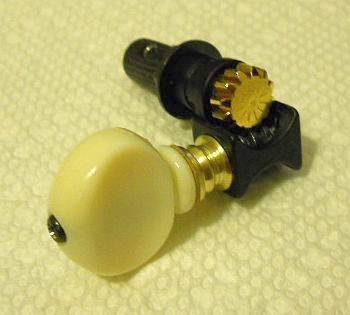
 |
|
#16
|
|||
|
|||
|
Quote:
Planetary banjo tuners is an interesting idea. |
|
#17
|
|||
|
|||
|
I found confirmation that these were Sperzels.
Search for Sperzel on these pages, and on the AGF pages, there is also bit of additional info. https://www.acousticguitarforum.com/...d.php?t=413438 https://www.acousticguitarforum.com/...d.php?t=297172 https://www.acousticguitarforum.com/...d.php?t=454131 https://www.musiciansfriend.com/guit...lectric-guitar http://www.tabrobot.com/rainsong-np1...tar-1472913694 |
|
#18
|
|||
|
|||
|
These are the timers that were used on my nylon string guitar. I selected them because the locking know wasnít as large as some others.
https://www.stewmac.com/parts-and-ha...iABEgK2UfD_BwE I considered the Spertzlís but I thought that fat capstan might look funny and after customizing a set, the cost started to ratchet up. |
|
#19
|
|||
|
|||
|
Quote:

|
|
#20
|
|||
|
|||
|
As an aside, Gotoh offers aluminum rollers as an option on Classical tuning machines. I believe they come in black or natural alum.
|
|
#21
|
|||
|
|||
|
I've also JB Welded aluminum barrel sleeves over regular steel string tuner string posts to increase the diameter and drilled through to intersect the original string hole. Worked fine. The larger barrel diameter not only changes how fast the string winds but it's kinder to synthetic strings that seem to like larger string post diameters.
|
|
#22
|
|||
|
|||
|
Quote:
I could imagine that several tubing options might be available. Plastics, aluminum, anodized aluminum (blacks, greys, virtually every color possible), carbon fiber tubing, and what not. The top opening of the tube on the post could be completed with a resin to fill and leave a rock hard glossy finish to the post top that I think would look nice. How did you keep the tubing exactly centered on the post after you epoxied? I suppose it doesn't have to be flawlessly centered for just winding strings, but to my mind, that would be the trickiest step. If there were too much error, being off-centered would likely become noticeable. |
|
#23
|
|||
|
|||
|
Quote:
http://web.archive.org/web/201604060.../pageUke1.html 
Last edited by Rudy4; 08-05-2020 at 07:50 AM. |
|
#24
|
|||
|
|||
|
Wow. Looks fantastic.
Great solution. Don't know yet if it's beyond my skill set, but I love being able to see DIY answers to questions like this. I'll head over to the link you added for more detail. Thanks for sharing. |
|
#25
|
|||
|
|||
|
That is brilliant!
|
|
#26
|
|||
|
|||
|
Quote:
If it is a sealed brass end, where do you find tubing with a sealed end? I looked at the link you gave and sadly, no photos there as the website/company is extinct--but text remains. I searched to see if someone had saved the full page somewhere else on the web, but found nothing. I did find reference to that same web page on a ukulele site. A builder there mentions it and mentions he had been doing the same thing using nylon sleeves for some time before Bluestem. So that would be before 2012, at least. So the idea of converting standard tuners to better suit nylon strings has been around for a while but it's sure difficult to track down the handful of people who have needed/wanted to do it. https://forum.ukuleleunderground.com...t+steel+string Note: link above has text that refers to photos--but I couldn't see them. Some forums I viewed in the past let only members see photos. I assume that's the case here or the photos are gone for some reason. Last edited by ac; 08-05-2020 at 04:02 PM. Reason: examined photo better |
|
#27
|
|||
|
|||
|
You could solder a piece of solid brass into the end or --- glue in a pearl or abalone fingerboard dot!
|
|
#28
|
|||
|
|||
|
|
|
#29
|
|||
|
|||
|
Quote:
The link is the Internet Archive Project's saved version of my old website. If you poked around the other pages for the website you found some pages had photos and some didn't. The photos are archived on the pages that got a lot of hits while lesser used pages didn't get all of the photos archived. It was my own personal website and not a forum. I maintained the website for several years and gave it up because I ran into a situation that the extra income generated from selling instrument construction guides was going to push me over a tax bracket that would effect my retirement investments in a negative manner. Since the question was about adding the enlargement sleeves to regular steel string posts I did the composite photo to post here. (I have all the source material for the old website, of course) Hopefully you found the text associated with the photos to be of use. |
|
#30
|
|||
|
|||
|
Quote:
For professionals like the OP, I'm sure they can easily use this information for their own creations without much more help. They have knowledge and experience I lack. But for me, the photos and all the other info is really helpful. I didn't connect all those instructional videos with you at the time I was web searching, but if I'm not mistaken, there were dozens and dozens of videos you produced on all sorts of topics from guitars to ukes to more. (Hopefully I'm connecting the dots correctly.) That's a lot of experience and knowledge. I'm sure many were sad to see that you needed to close down your site. Thank you for sharing this. Since these type of specialized tuners are not in big demand and seem to be pretty much a custom order, your solution opens the door to solve this issue gracefully. |